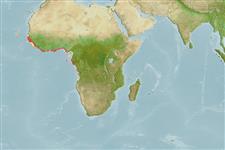>
Eupercaria/misc (Various families in series Eupercaria) >
Haemulidae (Grunts) > Plectorhinchinae
Etymology: Plectorhinchus: Greek, plektos = plaited + Greek, rhyngchos = snout (Ref. 45335).
More on author: Boulenger.
Environment: milieu / climate zone / depth range / distribution range
ນິເວດວິທະຍາ
ສັດທະເລ; ນ້ຳກ່ອຍ ກ່ຽວກັບ (ຢູ່)ເທິງຊັ້ນພື້ນດິນໃນທະເລເປີດ; ລະດັບຄວາມເລິກ 10 - ? m (Ref. 2683). Tropical; 15°N - 13°S
Eastern Atlantic: west African coast, from Senegal to Democratic Republic of Congo (Ref. 81655) and Angola (Ref. 7376, 57395).
ຂະໜາດ / ນ້ຳໜັກ / Age
Maturity: Lm ? range ? - ? cm
Max length : 53.8 cm TL ຕົວຜູ້/ບໍ່ມີເພດ; (Ref. 126428); common length : 30.0 cm TL ຕົວຜູ້/ບໍ່ມີເພດ; (Ref. 5476); ນ້ຳໜັກສູງສຸດທີ່ເຄຍຈັດພີມມາ: 2.8 kg (Ref. 126428)
ຄີ (ໜາມ)ແຂງຢູ່ຫຼັງປາ (ທັງໝົດ) : 14; ຄີຫຼັງຂອງປາ (ຄີອ່ອນ) (ທັງໝົດ) : 16; ຄີ(ໜາມ) ແຂງຢູ່ຄີກົ້ນປາ
ກຸ່ມປາກະດູກແຂງ
ຄວາມຖີ່ຂອງກຸ່ມຖ່າຍທອດພັນ
ປາທີ່ມີການເຄື່ອນຍ້າຍຈາກທະເລໄປຫານ້ຳຈືດ ແລະນ້ຳຈືດຫາທະເລ
ປາທີ່ມີການເຄື່ອນຍ້າຍຈາກທະເລແລະໄປໄຂ່ຢູ່ນ້ຳຈືດ
ຄີກົ້ນຂອງປາ
ສັດທີ່ມີກະດູກສັນຫັຼງ
ການຖ່າຍທອດທາງກຳມະພັນຈາກພໍ່ແມ່ຫາລູກ: 3; ຄີກົ້ນຂອງປາ: 7. Diagnosis: body oblong, rather deep; dorsal profile strongly convex at level of dorsal-fin origin (Ref. 57395). Snout at least as long as eye diameter (Ref. 57395), eyes large (Ref. 81655). Mouth oblique (Ref. 57395), small (Ref. 81655) with very thick (Ref. 57395) and fleshy (Ref. 81655) lips. Chin with 6 pores (erroneously reported as 4 since original species description; Ref. 81655), but without median pit (Ref. 57395). Dorsal fin long; second anal fin spine longest and stoutest; ctenoid scales covering body and head (except snout) and interradial membranes of soft parts of dorsal and anal fins (Ref. 57395). Caudal fin rounded (Ref. 57395, 81655).
Coloration: uniformly brown, more or less dark; young individuals often with lighter spots on flanks (Ref. 57395, 81655). In small specimens (< 60 mm SL), distal part of soft dorsal fin, posterior 3/4 of caudal fin and distal part of anal fin transparent (Ref. 81655).
Relatively rare species (Ref. 57395). Inhabits coastal waters (Ref. 3660, 57395), estuaries and coastal lagoons (Ref. 2683). Juveniles and sub-adults often in estuaries and lagoons (Ref. 2135, 57395, 81655), in freshwater (Ref. 2135), where sexual maturation begins (Ref. 57395).
Life cycle and mating behavior
ການຈະເລີນເຕັມໄວ | ການສືບພັນ | ການວາງໄຂ່ | ໄຂ່ | ຄວາມດົກຂອງໄຂ່ປາ | ຕົວອ່ອນ
Oviparous, distinct pairing during breeding (Ref. 205).
Roux, C., 1990. Haemulidae. p. 783-788. In J.C. Quero, J.C. Hureau, C. Karrer, A. Post and L. Saldanha (eds.) Check-list of the fishes of the eastern tropical Atlantic (CLOFETA). JNICT, Lisbon; SEI, Paris; and UNESCO, Paris. Vol. 2. (Ref. 6946)
IUCN Red List Status (Ref. 130435: Version 2024-1)
Threat to humans
Harmless
Human uses
ການປະມົງ: ເປັນສີນຄ້າ
ເຄື່ອງມື
Special reports
Download XML
ແຫຼ່ງອີນເຕີເນັດ
Estimates based on models
Preferred temperature (Ref.
123201): 22.6 - 27.9, mean 26.3 °C (based on 40 cells).
Phylogenetic diversity index (Ref.
82804): PD
50 = 0.5000 [Uniqueness, from 0.5 = low to 2.0 = high].
Bayesian length-weight: a=0.01950 (0.00835 - 0.04555), b=2.95 (2.76 - 3.14), in cm total length, based on LWR estimates for this (Sub)family-body shape (Ref.
93245).
ຊັ້ນເຂດຮ້ອນ (Ref.
69278): 3.8 ±0.6 se; based on size and trophs of closest relatives
ຄວາມຢືດຢຸ່ນ (Ref.
120179): ຂະໜາດກາງ, ປະຊາກອນຕຳ່ສຸດທີ່ໃຊ້ເວລາສອງເທົ່າ 1.4 - 4.4 ປີ (Preliminary K or Fecundity.).
Fishing Vulnerability (Ref.
59153): Moderate vulnerability (42 of 100).
Climate Vulnerability (Ref.
125649): Very high vulnerability (89 of 100).
Nutrients (Ref.
124155): Calcium = 72.6 [20.8, 161.1] mg/100g; Iron = 0.726 [0.384, 1.531] mg/100g; Protein = 17.8 [15.9, 19.8] %; Omega3 = 0.176 [0.077, 0.347] g/100g; Selenium = 56.4 [26.6, 114.0] μg/100g; VitaminA = 20.4 [7.2, 56.7] μg/100g; Zinc = 1.19 [0.77, 1.83] mg/100g (wet weight);
